 |
| Meredith Quinn, newly certified PACS administrator |
Friday, November 27, 2020
PARCA certifications seen as key to career change
RSNA 2020 goes virtual for Nov. 29 to Dec. 5 annual meeting
PARCA eNews – Nov. 11, 2020 – RSNA 2020 forges ahead with its annual meeting going online with a virtual meeting venue, and people are getting used to attending such meetings.
As of this writing, over 16,000 people had registered for sessions being held Nov. 29-Dec.5, 2020. The number of virtual only registrations in 2019 were 2,487.
“We’re very pleased to have this many attendees registered so far in advance of our first-ever entirely virtual event, and we expect registration to continue to grow,” said RSNA president James P. Borgstede, MD in a press release.
“We’re very pleased to have this many attendees registered so far in advance of our first-ever entirely virtual event, and we expect registration to continue to grow,” said RSNA president James P. Borgstede, MD in a press release.
Data breaches spike in September led by Blackbaud
PARCA eNews – Nov. The number of breaches and records compromised spiked in September with 95 healthcare breaches reporting 9.7 million medical records reported to the US Department of Health and Human Services breach portal.
The number of healthcare breaches nearly tripled with a fourfold increase in the number of records compromised.
The number of healthcare breaches nearly tripled with a fourfold increase in the number of records compromised.
The massive increase was primarily due to ransomware attacks include a massive attack on Blackbaud, which provides cloud services, financial management and analytics for a large number of non-profit organizations including foundations, universities, hospitals and healthcare organizations.
Training radiologists with AI seen as key to radiology tech leadership
PARCA eNews – Nov. 6, 2020 – A new pathway for radiologists in training has been developed at Brigham & Women’s Hospital that pairs fourth-year radiology students with AI developers to both improve AI and to integrate radiology residents with an AI future in radiology practice.
Recognizing that artificial intelligence and machine learning is here to stay, Brigham and Women’s designed a curricula that combines AI and radiology.
Recognizing that artificial intelligence and machine learning is here to stay, Brigham and Women’s designed a curricula that combines AI and radiology.
'Fast MRI' detects significantly more breast cancer in women with dense breasts
PARCA eNews – Nov. 3, 2020 – Should women with dense breasts be routinely referred for simplified MRI technique following a negative 3D mammogram? That is the question researchers at Penn Medicine of the University of Pennsylvania are asked following results of a February 2020 JAMA Network study.
That clinical trial compared 3D mammography to abbreviated or fast MRI in 1,444 women with dense breasts. The researchers showed that 3D mammography detected 7 invasive cancers, compared to 17 detected with fast MRI, which was considered a significantly higher rate of cancer detection.
That clinical trial compared 3D mammography to abbreviated or fast MRI in 1,444 women with dense breasts. The researchers showed that 3D mammography detected 7 invasive cancers, compared to 17 detected with fast MRI, which was considered a significantly higher rate of cancer detection.
Microsoft makes big bid for Cloud imaging data for healthcare
Microsoft announced a new Microsoft Cloud for Healthcare on Oct. 28. The new offering includes the company’s cloud-based DICOM server that can be used together with Microsoft’s Azure programming interface for fast interoperability.
Friday, November 20, 2020
Declining radiology revenues continue
PARCA eNews – Oct. 30, 2020 – Reimbursement for radiology services have been declining over the past decade according to a study in the Journal of the American College of Radiology. The study analyzed global fees, which encompass both the technical and professional components of reimbursement.
The declining payment trends began with reductions to diagnostic radiology services following the Deficit Reduction Act of 2005 and affected multiple modalities including bone densitometry, CT, CT angiography, mammography, MR angiography, MRI, nuclear medicine, radiography, and ultrasound.
The declining payment trends began with reductions to diagnostic radiology services following the Deficit Reduction Act of 2005 and affected multiple modalities including bone densitometry, CT, CT angiography, mammography, MR angiography, MRI, nuclear medicine, radiography, and ultrasound.
HHS adopts final HealthIT strategic plan
PARCA eNews – Oct. 30, 2020 – The U.S. Department of Health and Human Services (HHS) published its final 2020-2025 Federal Health IT Strategic Plan (the Plan) Oct. 30, 2020, which includes provisions for supporting patient access to their own health information.
Tuesday, November 17, 2020
HHS extends compliance dates for information blocking and Health IT certification requirements
Oct. 29, 2020 – The US Health and Human Services has extended the deadline for compliance with a number of requirements of the 21st Century Cures Act in response to challenges to organizations complying resulting from the pandemic.
Last March ONC’s Cures Act Final Rule established exceptions to the 21st Century Cures Act’s information blocking provision and adopted new health information technology (health IT) certification requirements to enhance patients’ smartphone access to their health information at no cost through the use of application programming interfaces (APIs).
The interim final rule issued Oct. 29, 2020 extends the program compliance dates beyond those identified in the April 21, 2020 as follows:
Monday, September 28, 2020
Universal patient identifiers are about patient safety
 |
| Photo credit: University of Texas, Austin |
In 2018, Miri was congressionally appointed by Senator Chuck Schumer to the Health and Human Services (HHS), federal Health IT Advisory Committee, established under the 21st Century Cures Act. He was federally appointed by HHS Secretary Sylvia Burwell to serve on the HHS Health IT Policy Committee established under the American Recovery and Reinvestment Act of 2009. Miri is the prior chair of the Healthcare Information and Management Systems Society (HIMSS) National Public Policy Committee and serves as an expert adviser to the United States Senate Committee on Health, Education, Labor and Pensions and to other congressional panels engaged in numerous Health IT policy topics. PARCA eNews spoke to Mr. Miri about the challenges of adopting a national universal patient identifier.
Patient ID Now Coalition delivers 3 recommendations to ONC workshop
 |
| Courtesy of Patient ID Coalition |
HIMSS Vice President for Government Relations Tom Leary and Meryl Bloomrosen, Senior Director, Federal Affairs for Premier Healthcare Alliance, represented the Patient ID Now Coalition at the session during the Alliances & Coalitions segment.
As part of their observations, the Patient ID Now Coalition made the recommendations following a necessary first step of Congress removing Section 510 of Labor HHS Appropriations, which bans HHS from promulgating a unique patient identifier.
First ransomware attack tied to patient death, negligent homicide charge possible
PARCA eNews – Sept. 18, 2020 – In what is believed to be a first, a ransomware attack has led to a patient death according to reports in HIPAA Journal and Fortune Magazine.
The Sept. 10, 2020 attack crippled the Heinrich Heine University Clinic in Dusseldorf, Germany. The 78-year-old woman patient required immediate emergency treatment for an aneurysm and had to be diverted to another emergency facility 21 miles away. The one-hour delay was noted as contributing the the patient’s death.
The Sept. 10, 2020 attack crippled the Heinrich Heine University Clinic in Dusseldorf, Germany. The 78-year-old woman patient required immediate emergency treatment for an aneurysm and had to be diverted to another emergency facility 21 miles away. The one-hour delay was noted as contributing the the patient’s death.
CMS announces innovative payment model for radiation oncology
The new Radiation Oncology model allows for value-based focus by creating a simpler, more predictable payments that incentivize cost-efficient and clinically effective treatments to improve quality and outcomes. Current payment is based on the number of treatments and where patients receive it such as in a hospital outpatient department or a freestanding radiation therapy center, which can lead to more time traveling for treatment with little clinical value, according to CMS Administrator Seema Verma.
Trend to home PACS for radiology likely to continue
PARCA eNews – Aug. 9, 2020 – Radiologists will be shifting more of their workdays to reading from home or other remote locations after the COVID-19 crisis has passed, according to a new survey.
In an effort to examine effects of COVID-19 on radiology practices, a group of radiologists conducted a survey of nearly 290 practices representing a geographically diverse cross section of institutions. The results were published in mid-May in the Journal of the American College of Radiology.
PHI vulnerable to extraction from online presentations
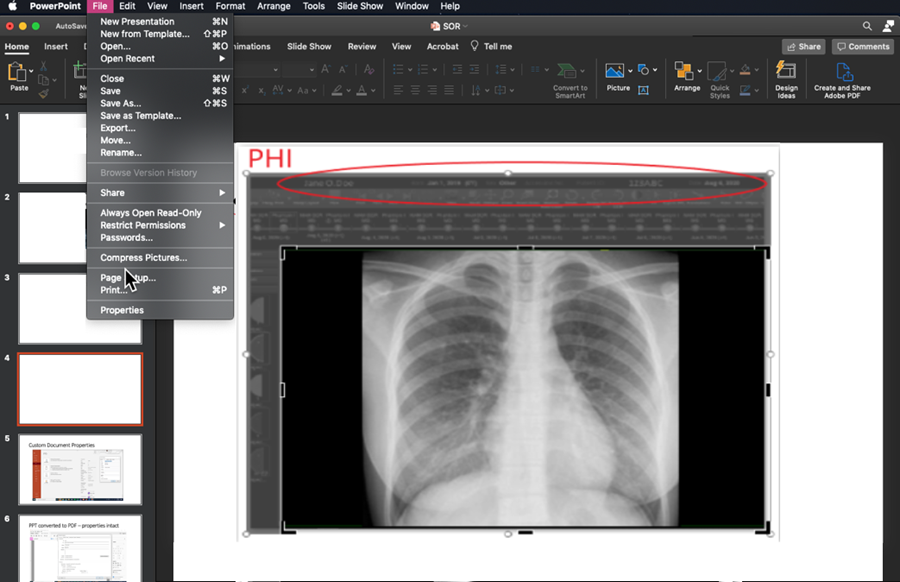 |
| Patient data can be extracted from Images imported from a PACS into an online PowerPoint |
PARCA eNews – Aug. 28, 2020 – The Radiological Society of North America (RSNA), the American College of Radiology (ACR), and the Society for Imaging Informatics in Medicine (SIIM), are warning that online medical presentations are at risk of accidental exposure of protected health information (PHI).
In a paper on the ACR website, the group shows how advances in web-crawling and content processing technology is increasingly able to allow large-scale information extraction from previously stored files. The technology allows extraction of medical images contained in PowerPoint presentations and PDF files and recognized alphanumeric character information embedded in those images, including patient information.
KA imaging technology given FDA nod; begins COVID-19 early detection trial
PARCA eNews – September 22, 2020 – The U.S. Food & Drug Administration (FDA) awarded 510(k) clearance to Ka Imaging, Inc., Monday for Reveal, its portable, dual-energy X-ray detector that, company officials, said can be used to slow the spread of COVID-19.
The company’s Reveal™ machine enables bone and soft-tissue differentiation without motion artifacts in a single X-ray exposure. In other words, with one shot, the detector simultaneously delivers DR, bone, and tissue images.
The company’s Reveal™ machine enables bone and soft-tissue differentiation without motion artifacts in a single X-ray exposure. In other words, with one shot, the detector simultaneously delivers DR, bone, and tissue images.
Pandemic pushes telehealth to top IT concerns
 |
| Credit Office of Connected Care - Veterans Affairs |
The survey found that 8 of 19 executives named solving telehealth problems as their number one problem during the early stages of the pandemic. Since then, nearly all of the executives say they have workable solutions in place, or are implementing one.
Monday, July 27, 2020
Full benefits of AI in radiology requires evaluating human impacts
Elizabeth Krupinski, PhD, is Professor and Vice Chair for Research in the Department of Radiology and Imaging Sciences at Emory University School of Medicine. She is a member of the Academy for Radiology & Biomedical Imaging Research. Prior to joining Emory, Dr. Krupinski was a Professor at the University of Arizona in the Departments of Radiology, Psychology and Public Health, and was also Vice Chair of Research in Radiology. She is past chair of the SPIE Medical Imaging Conference, past president of the American Telemedicine Association, and past chair of the Society for Imaging Informatics in Medicine. Dr. Krupinski’s research interests are in medical image perception, observer performance, medical decision making, and human factors as they pertain to radiology and telemedicine. Dr. Krupinski received the Academy of Radiology Research Distinguished Investigator Award in 2014 and the ATA President's Award for Individual Leadership in 2017. She serves on a number of editorial boards for both radiology and telemedicine journals and is the Co-Editor of the Journal of Telemedicine & Telecare. She serves regularly as a grant reviewer for the NIH, DoD, TATRC and other federal, state and international funding agencies and has served as a member of a number of FDA review panels. She is a frequent and sought after speaker at medical imaging conferences. PARCA-eNews spoke to her by phone about her perceptions and observations about artificial intelligence (AI) implementations in radiology.
COVID-19 spurs deployment of at-home PACS
 |
| Photo credit – BARCO, Inc. |
Srini Tridandapani and colleagues at UAB’s Radiology Department successfully deployed more than two dozen at-home radiology workstations within a couple of weeks time. The group recounted their experience in the May 20 issue of the American Journal of Roentgenology.
Remote medical imaging reading is here to stay
 |
| Credit HealthImaging |
In a report on the SIIM virtual meeting in June, by Matt O’Connor for HealthImaging, a panel discussion on "Remote Reading in the COVID-19 Era," Matthew Hayes, a PACS manager at Radiology Partners made the case for PACS administrators to plan for this growing trend shift to remote reading.
ONC's Tech Forum to go virtual Aug. 10-11
 |
| Credit – Analytics India Magazine |
Imaging finds inflammatory syndrome in kids with previous exposure to SARS-CoV-2
 |
| Image credit – Evelina Children's Hospital |
The children were admitted to the Evelina London Children’s hospital in London for fever, abdominal pain, vomiting, diarrhea and conjunctivitis (pink eye). Chest x-rays in 19 of the patients showed bronchial wall thickening, chest CT scans found collapsed lung with pleural effusion (fluid in the lungs) but no embolisms.
Web-based lung and COVID-19 imaging data management system offered free
PenRad donates its PenLung CT tracking software
Microsoft re-issues warning to patch Exchange server security
 |
| Credit Microsoft Security |
PARCA eNews – June 24, 2020 – Microsoft has issued a further warning to all Exchange users to patch the critical Microsoft Exchange memory corruption vulnerability CVE-2020-0688.
Microsoft released an update to correct the vulnerability in February 2020 and an alert was issued in March when the flaw started to be exploited by APT groups according to HIPAA Journal.
Microsoft released an update to correct the vulnerability in February 2020 and an alert was issued in March when the flaw started to be exploited by APT groups according to HIPAA Journal.
Flaw in Philips ultrasound machines allows bypass of authentication
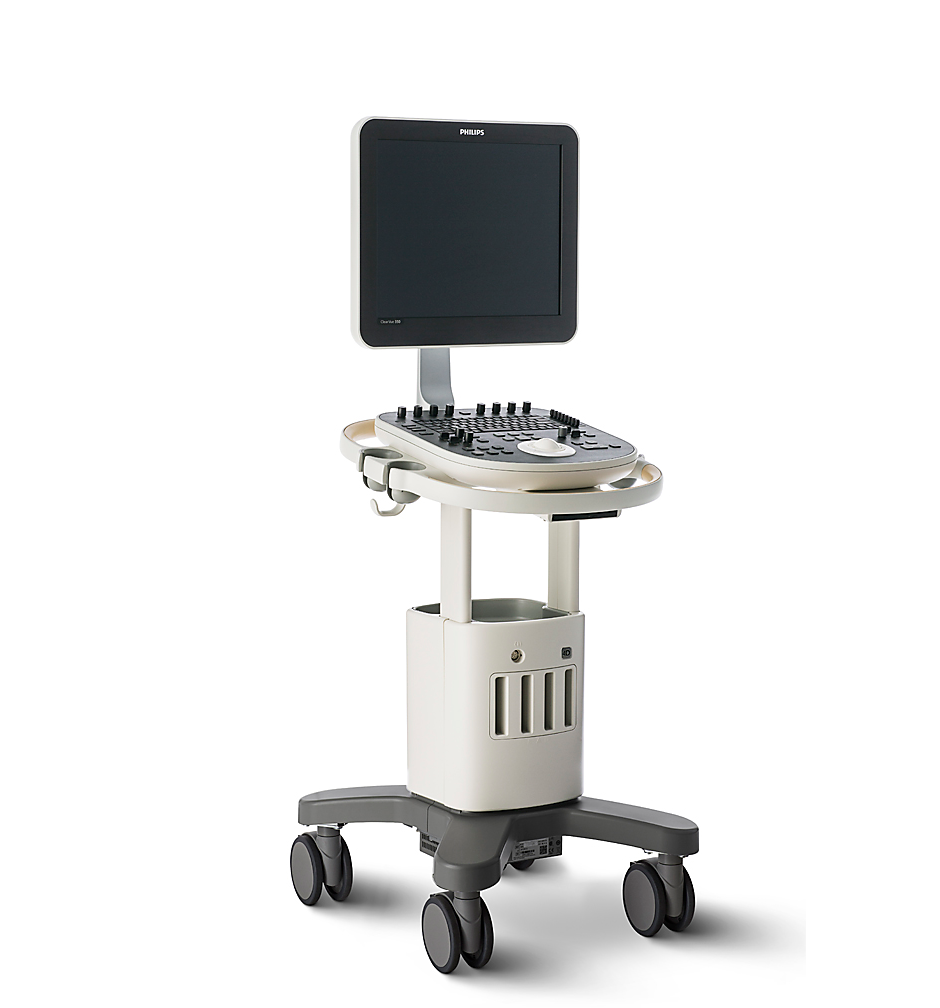 |
| Photo credit Phillips |
FBI and CISA warn organizations of risks of TOR users
PARCA eNews – The Cybersecurity and Infrastructure Security Agency (CISA) last week released a joint report with the Federal Bureau of Investigation (FBI) warning of cyber-attacks using The Onion Router (Tor).
Tor is software that allows users to browse the web anonymously by encrypting and routing requests through multiple relay layers or nodes. While this software can be used legally to protect individuals who wish their information to remain anonymous on the internet, cyber threat actors can use Tor software and network infrastructure for anonymity and obfuscation purposes to clandestinely conduct malicious cyber operations.
Tor is software that allows users to browse the web anonymously by encrypting and routing requests through multiple relay layers or nodes. While this software can be used legally to protect individuals who wish their information to remain anonymous on the internet, cyber threat actors can use Tor software and network infrastructure for anonymity and obfuscation purposes to clandestinely conduct malicious cyber operations.
Thursday, May 28, 2020
Adding the next layer of security: offensive cybersecurity research
 |
Offensive cybersecurity researcher Vasilios Hioureas
|
Friday, May 15, 2020
3D Scanners making their way into clinics and hospitals
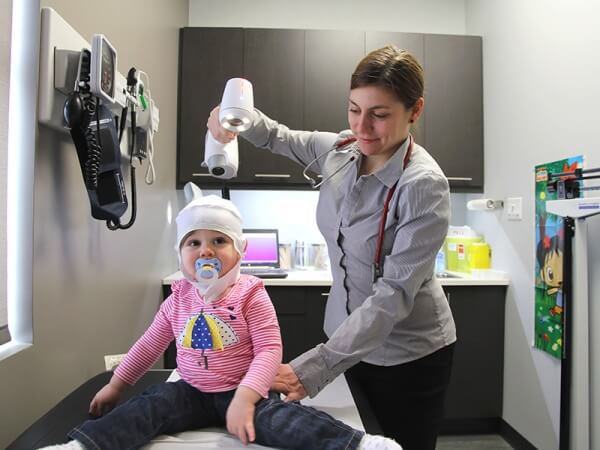 |
| Tech scans the cranium of a child – Image credit Sculpteo |
Much less attention has been paid 3D scanners, which are being developed in conjunction with 3D printing. Currently being developed and experimented in academic research institutions, 3D scanning tools may soon make their way into hospitals, clinics and even doctors’ offices.
Tuesday, May 12, 2020
CISA and FBI issues top 10 cybersecurity exploits
PARCA eNews – May 12, 2020 – The Cybersecurity and Infrastructure Security Agency (CISA), the FBI released its latest list of cybersecurity exploits over the past 4 years. The technical guidance is intended to help IT security professionals at public and private sector organizations prioritize security efforts.
Sunday, May 10, 2020
Healthcare IT professionals jump into the COVID-19 fray
 |
Enli’s COVID-19 care coordination solution is a
cloud-based patient tracking program
|
As part to the Office of the National Coordinator’s Interoperability Proving Ground, the subset of interoperability projects focused specifically on COVID-19 mushroomed with projects ranging from care coordination tracking programs to COVID patient monitoring and tracking projects to assessment tools for determining whether a person should be tested along with links to the person’s local health authority for testing.
Friday, May 8, 2020
COVID--19 spurs uptick in cybersecurity attacks
PARCA eNews – May 8, 2020 – In a March 2020 consulting firm Deloitte issued a report entitled ‘COVID-19’s Impact on Cybersecurity’ showing that cybercriminals are capitalizing on the pandemic.
The report issued by the company’s Cyber Intelligence Center noted a spike in phishing attacks, malware and ransomware attacks since the COVID-19 crisis has prompted companies, government agencies and private institutions conduct more business via remote computer connections.
Thursday, May 7, 2020
ONC and CDC compile a single-page COVID-19 resource page
PARCA eNews – May 7, 2020 – The Office of the National Coordinator in collaboration with the Centers for Disease Control and Prevention (CDC) has compiled a comprehensive list of resources for Health IT tracking, and dealing with the government response to the COVID-19 pandemic. The resources are aimed at providing clear direction for electronic health information exchanges and facilitate effective strategies to combat COVID-19 including:
Saturday, May 2, 2020
AHA issues guidelines for secure working from home
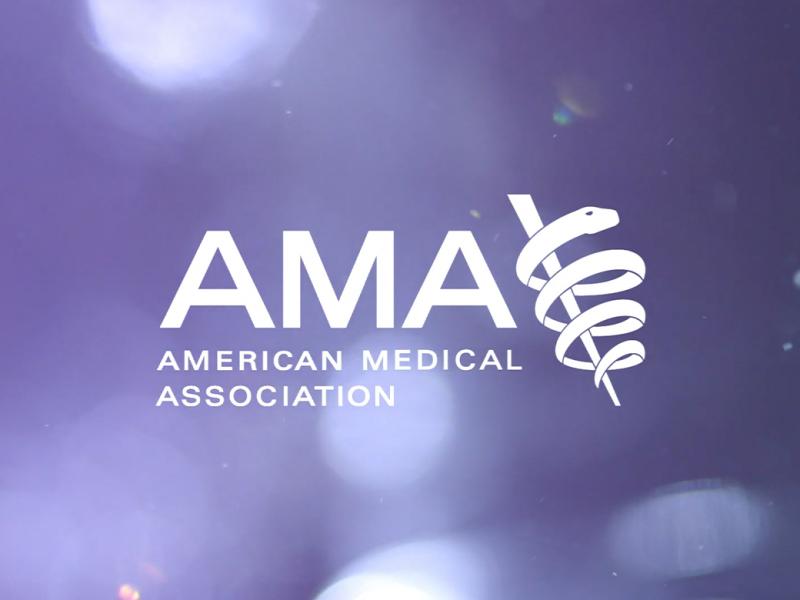
PARCA eNews – May 2, 2020 – With many physicians and healthcare providers working from home and seeing patients via telehealth platforms, the American Hospital Association (AHA) and American Medical Association (AMA) published guidelines to ensure such communications remain safe from cyber threats and comply with privacy regulations.
Noting that cyber criminals are taking advantage of the COVID-19 crisis to target physicians and other health providers to gain access to patient records information.
To help providers to protect their computers and home networks, the organizations compiled a checklist of actions providers should take immediately to strengthen their cybersecurity. Acknowledging the checklist is not an exhaustive list of security measures, the list covers most of the basic measures IT professionals routinely use for office and clinic networks. It covers safeguards that need to be taken for passwords, web browsers, antivirus software, updated operating systems and firewalls.
Tuesday, April 21, 2020
ONC, CMS ease enforcement of Interoperability Final Rules in response to COVID-19 crisis
 |
| Don Rucker, MD National Coordinator for Health Information Technology (ONC) |
PARCA eNews – April 21, 20220 – The Office of the National Coordinator for Health IT (ONC) and the Centers for Medicare & Medicaid Services (CMS), in conjunction with the HHS Office of Inspector General (OIG) announced today compliance flexibilities regarding the implementation of the interoperability final rules announced on March 9, 2020.
The relaxation of enforcement was a policy decision made as a result of the COVID-19 emergency.
Wednesday, April 1, 2020
Imaging practices impacted by COVID-19
 |
| Photo credit – Diagnostic and Interventional Cardiology |
As cases of acute cardiovascular disease and cardiac complications caused by COVID-19 rose dramatically in early March and April, all the major cardiovascular imaging societies issued COVID-19 guidelines and lists of considerations for how to continue imaging operations safely under the threat of viral contamination for the duration of containment efforts.
Thursday, March 26, 2020
FHIR lighting the way to patient record sharing
 |
| Grahame Grieve of Health Intersections, PTY LTD – photo credit HiMSS 19 |
Wednesday, March 25, 2020
Scientists develop handheld imaging device with 100 times higher resolution than CT
Friday, March 20, 2020
CMS expands telehealth services covered by Medicare
 |
A patient and his medical provider communicate
via Video Technology Conferencing (VTC).
|
The policy changes that provide coverage for a greater range of services delivered by telehealth systems build on the regulatory flexibilities granted under the President’s emergency declaration.
Monday, March 16, 2020
Radiology shifts from diagnostic testing to preparedness for COVID-19
PARCA eNews –March 16, 2020 – In the early rise of the COVID-19 crisis in Wuhan, China, hospitals and government public health authorities were relying on chest CT findings of peripheral ground-glass infiltrates and or organizing pneumonia as a surrogate for COVID-19 infection.
Thursday, March 12, 2020
Most medical imaging devices run on outdated operating systems
PARCA eNews – March 12, 2020 – An overwhelming majority (83 percent) of medical imaging devices are running old operating systems with little to no ability to receive crucial security updates according to a new report by security tech form Palo Alto Networks.
Wednesday, March 11, 2020
Radiology group reports PACS hack
PARCA eNews – March 11, 2020 –Northeast Radiology today announced that it is addressing a data security incident, caused by unauthorized individuals, which may have involved the personal information of some patients.
Northeast Radiology and its healthcare management services provider, Alliance HealthCare Services, have completed an investigation with a leading forensic security firm and are evaluating systems and processes to help prevent future occurrences.
Monday, March 9, 2020
HHS and CMS issue final interoperability rules
PARCA eNews – March 9, 2020 –The US Department of Health and Human Services (HHS) and the Centers for Medicare & Medicaid Services (CMS) today announced the final rules for implementing interoperability and patient access provisions of the 21st Century Cures Act.
Friday, March 6, 2020
HiMSS 2020 cancelled due to Covid-19 concerns
 |
| The Orlando Convention Center, site of HiMSS 2020 was empty as a result of the cancellation of HiMSS 2020 |
Thursday, March 5, 2020
VNA and PACS market to grow to $3.87 billion by 2023
PARCA eNews – March 5, 2020 – Meticulous Research, a global market research company published a research report on its global forecast to 2023 for the VNA and PACS market.
Meticulous Research analyzed the vendor neutral archive (VNA) & picture archiving and communication system (PACS) market is expected to grow at a compound annual growth rate (CAGR) of 7.2% from 2018 to reach $3.87 billion by 2023.
Meticulous Research analyzed the vendor neutral archive (VNA) & picture archiving and communication system (PACS) market is expected to grow at a compound annual growth rate (CAGR) of 7.2% from 2018 to reach $3.87 billion by 2023.
Monday, January 27, 2020
Operating an open source PACS
Avram Adam is Network/Systems Administrator at Arizona State Radiology group, which operates 13 locations and provides radiology services to four hospitals in the Tucson area. Adam has been working in PACS for radiology for about two years and before that worked with the City of Tucson and at a credit union primarily in systems administrator and network administrator roles. As chief technology officer as well the HIPAA security officer for Arizona State Radiology he manages all the networking systems, which handle about a half a million studies a year.
Q. What prompted you to seek open source PACS solutions?
Because current offerings don’t have all of the functionality we are looking for.
Q. What prompted you to seek open source PACS solutions?
Because current offerings don’t have all of the functionality we are looking for.
Saturday, January 18, 2020
DHS warns of Citrix vulnerability under attack
Wednesday, January 15, 2020
Public comment sought on ONC 5-year plan
The plan was developed in collaboration with over 25 federal organizations and is intended to guide federal health information technology (IT) activities over the course of the year.
Wednesday, January 8, 2020
MAZE malware adds blackmail element to ransom demand
Dubbed MAZE, the ransomware uses multiple methods for intrusion, including creation of malicious look-alike cryptocurrency and spam campaigns impersonating government agencies.
Thursday, January 2, 2020
The view for 2020: AHIMA continues to push for patient safety in 2020
PARCA eNews _ Jan. 2, 2020 – Despite the setback to lifting the decades old ban on development of a universal patient identifier last September, the American Health Information Management Association (AHIMA) vows to continue to push forward on patient safety by making 2020 the year of Patient Matching.
Mary Butler outlined AHIMA’s goals for 2020 in an article on the organization’s website, stating that, "AHIMA has never waited for Congress to start advocating for better ways to improve patient safety, so the association is ready to make 2020 “The Year of Patient Matching” regardless of whether the Senate votes to remove the ban on a UPI." Ms Butler wrote."
Mary Butler outlined AHIMA’s goals for 2020 in an article on the organization’s website, stating that, "AHIMA has never waited for Congress to start advocating for better ways to improve patient safety, so the association is ready to make 2020 “The Year of Patient Matching” regardless of whether the Senate votes to remove the ban on a UPI." Ms Butler wrote."
Subscribe to:
Comments (Atom)



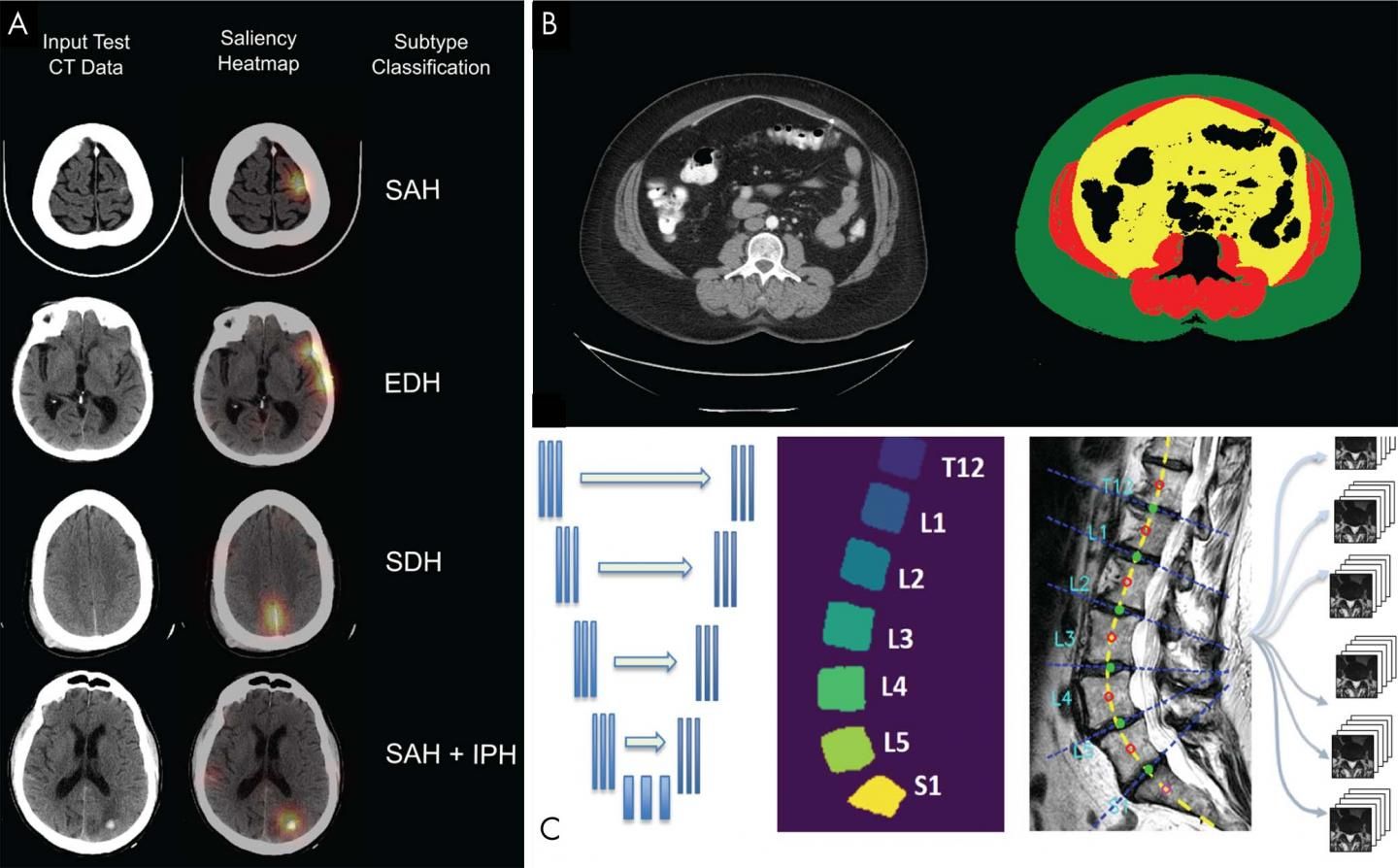
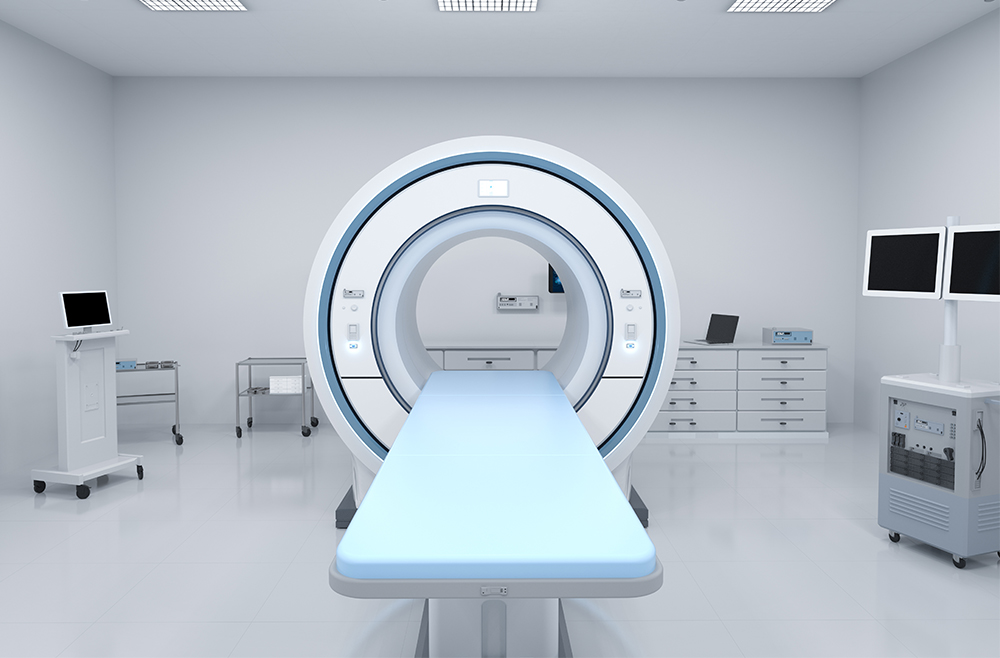

















.jpg)






